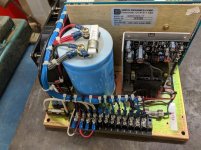I'm doing the planning to put a new control in a machine I just got here, it has a 220v 3 phase spindle that runs on a 200-230v VFD. It has 140v 8.6A SEM DC brushed servos. It has a 2kva primary 240x480 secondary 120x240 transformer feeding the servo drives with no further step down from the simple (capacitor and rectifier only) power supply on board the servo rack. I know that this machine was previously running on 240v via rotary phase converter before I got it. The resultant voltage to the drives measures 171v; makes sense because theoretically recified 120vac x 1.414=170vdc. From what I've read you are supposed to feed these motors less than their rated 140vdc, so I'm assuming I should use a 2kva transformer with 100v or slightly lower out to run this, correct? or are the drives able to handle that voltage & protect the motors from over voltage (because they have been running like that)? either that is the case or POSSIBLY the machine was originally spec'd to run on 208, but even that into the transformer would result in 147vdc
Can I run with this PSU or do I need to buck to under 100vac input?
Can I run with this PSU or do I need to buck to under 100vac input?




